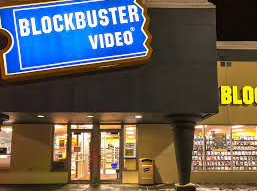Netflix, Disney+, Paramount, Hulu, and HBO Max are just some of the hundreds of streaming services that are available today. What about a time when these streaming services were not readily available with thousands of movies to watch for a monthly rate? In 2023, these luxuries are normal, but to get to this place it took years of innovation and development. It all started with Blockbuster.
Blockbuster, created by David Cook in 1985, was a video rental store which offered more than 8,000 VHS tapes. It had the help of a computerized check out system, which set it apart from other smaller video rental stores. The idea of renting movies after they were released, and not having to buy them if you wanted to see them, was not at all uncommon during the 80’s, 90’s, and early 2000’s. However, Blockbuster took this experience to a whole new level. Due to the subtle differences in the way Cook ran Blockbuster, the brand gained a following very quick. So quick, that the next year Cook opened three new stores. By 1987, three major investors took a chance on the company and invested $18.5 million dollars into Blockbuster.
After David Cook left the Blockbuster company in 1988, the company grew even larger, buying other smaller video rental stores. By the end of the year, Blockbuster acquired 800 stores within the United States. Fast forward to 1994, Blockbuster reached 6,000 stores world-wide. As a result, a mass media company known as Viacom bought Blockbuster for $8.4 million dollars.
While Blockbuster was on its rise to fame, the primary way that Blockbuster made its money was through late fees. Every day a person was late in giving back their rented movie they would have to pay a fee. This rule made up 16% of Blockbusters’ revenue, which annoyed many customers. One of those customers being Reed Hastings, the creator of Netflix.
In 1997, Reed Hastings and Marc Randolph collaborated to create Netflix. This new company would send DVDs straight to a person’s house for a monthly rate, and most importantly included no late fees. Even though Netflix wouldn’t switch to streaming until 2007, this new innovation was the start of a change in the movie industry. Although Netflix was convenient and beneficial to the audience, it was a disruptive innovation for Blockbuster. Blockbuster even had the opportunity to buy Netflix in the early 2000’s but they decided against it. After a while, Blockbuster even forgot about Netflix. Another one of Blockbusters competitors, Redbox, was rising around this time as well.
Even with the newfound competition, Blockbuster hit its peak in 2004, bringing in around five billion dollars and having about 9,000 stores. Even though Blockbuster was in the best place the company had ever been in, they would start to fall down from their peak. With Viacom leaving in 2004, the company launched Blockbuster online, but this program was already years behind their competition, Netflix.
While Blockbuster online was just getting started, they also decided to make the costly decision to stop charging late fees. At this point, Blockbuster’s revenue was coming down with stores closing at a rapid pace from 2005 to 2009. In 2010, Blockbuster filed for bankruptcy. The company would quickly be brought out of bankruptcy by Dish Network in 2010, and would just as quickly close remaining stores in 2013. Only one lonely store still stands in the state of Oregon in 2023. In an ironic turn of events, almost 10 years after Blockbuster closed its remaining stores, Netflix created a show about the last standing Blockbuster store.
With a combination of not adapting to their audience’s desires fast enough, and not adapting to the world’s new technological advances, Blockbuster fell. Blockbuster prompted a change in the way people look at watching movies, adding a certain type of comfort to watching a movie from home. Even though the company failed in the end, they paved the way for online movie companies to succeed.









carl • Aug 13, 2024 at 12:30 am
really enjoyed your work
Allison Checkley • May 30, 2024 at 1:07 pm
I loved this article, it was very informative. The timeline was very clear and the article was overall very detailed.